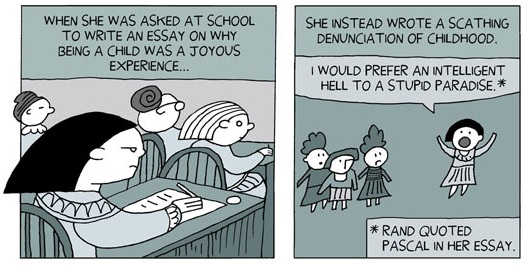This week’s link theme is art, so I’d like to start by highlighting a fundraising drive being run by the branch of the Dominicans I knew in DC. They’re publishing a hymnal of the Gregorian chant they use when they pray the Liturgy of the Hours. You can order one yourself or sponsor one (or more) for a friar.
I’ve ordered one for myself, so now I’ll need to bother the brothers next time I visit to explain to me how to read Gregorian chant notation. Below, you can hear one of the pieces that will be in the hymnal:
The next is also a form of art that involves the audience. It’s… well… Lucha Libro:
It’s a twist on Lucha Libre, Mexico’s version of pro wrestling, where competitors put on masks and pseudonyms to duke it out in a ring.
Peru’s Lucha Libro is kind of like that, without the violence. It’s literary “wrestling.” New writers don masks, and head onto a stage where they’re given three random words, a laptop hooked up to a gigantic screen, and five minutes to write a short story.
At the end of a match, the losing writer has to take off his or her mask. The winner goes on to the next round, a week later. And the grand prize? It’s a book contract…
I’ve also been enjoying the ongoing biography of Ayn Rand presented as a graphic novel online. It is better than the biopic with Helen Mirren.
The Atlantic had an interesting feature interview with two MIT researchers about the way science fiction interacts (or should interact) with just plain science. One of them said:
Fiction, specifically science fiction, is a way to see, as Cervantes would say, “life as it ought to be,” not just life as it is. Storytelling is how the human brain understands reality, by comparing the input it is currently sensing and comparing it to stories it’s experienced or heard before.
Fiction allows you to live more lives in the space-time of one lifetime than you would normally be able to.”
On the deepest levels, your consciousness doesn’t make a distinction between experiences you’ve had and the experiences of characters in stories you’ve heard. This is why fiction is so powerful and why human beings seem to need to tell, collect, and understand stories. Fiction allows you to live more lives in the space-time of one lifetime than you would normally be able to. It allows you to benefit from the outcome of simulations without being exposed to the dangers or time constraints that you would be forced to undergo if you had to live every experience that informs your reality by yourself. In a post-industrial society of tool using primates, like ours, technology is one of the defining factors, and so science fiction, with its tendency to emphasize technology, is a way of running exponentially iterative design processes to conceive and create new technologies.
And, as the Ayn Rand biography makes clear, it also helps you go surveying across political and cultural ideaspace, not just technological. And there there be dragons.
Forrest Fenn has also used creative writing to spark exploration. A latter day Captain Flint, he has allegedly hid over $3 million in the American Southwest, and has published a cryptic poem, and then a book, to guide future treasure hunters.
I liked best the way that the treasure hunters studied Flynn, as much as his poem, to try to divine his reasoning:
Dal Neitzel is just one of hundreds of people who have contacted Fenn to let him know they’ve been searching for his haul. Before he set out, after poring through historical books and scouring maps, Neitzel, a 65-year-old former TV cameraman, convinced himself the treasure was in the Rio Grande Gorge in New Mexico, close to the border with Colorado. Remarkably, he’d managed to locate a large house on the edge of a steep drop that overlooked a gushing river. Outside that house was a sign that read: ‘Brown’. He read Fenn’s poem aloud again: “Put in below the home of Brown.” That had to be it.
But after days spent scouring the river bed and banks, he knew it wasn’t. “Today I’d walk right past that spot because one of the things we know is that when Forrest hid the treasure he intended for it to potentially stay hidden for 1,000 years,” he says. “If nobody finds it right away it’s OK with him. And so he couldn’t possibly be referring to a living person by the name of Brown because they – and their house – won’t be there in a thousand years.
“It must refer to something historical,” Neitzel says. “Something written in history. Something geological, perhaps. Something that someone could continue to find forever.”
As I near the end of the quick takes, the links between links get a little more tenuous, but this next is also about communication that requires someone else to complete your work. From the annals of Improbable Research, Jeff Van Bueren and confederates set out to see what the limits were on what the Post Office would mail. For example:
Wrapped brick. Wrapped in brown paper; posted in street corner box with same amount of postage as was strapped to unwrapped brick. Extreme weight for size made package seem suspicious. Notice of attempted delivery received, 16 days. Upon pickup at station, our mailing specialist received a plastic bag containing broken and pulverized remnants of brick. Inside was a small piece of paper with a number code on it. Our research indicates that this was some type of US Drug Enforcement Agency release slip. The clerk made our mailing specialist sign a form for receipt.
But what I liked best were the notes from the conclusion of the research:
Finally, our investigation team felt remorse for some of its experimental efforts, most particularly the category “Disgusting,” after the good faith of the USPS in its delivery efforts. We sought out as many of the USPS employees who had (involuntarily) been involved in the experiment as we could identify, and gave them each a small box of chocolate.
And finally, since I promised you art (and therefore you might reasonable be expecting beauty), let me leave you with a lovely visualization of Simpson’s paradox.
For more Quick Takes, visit Conversion Diary!














